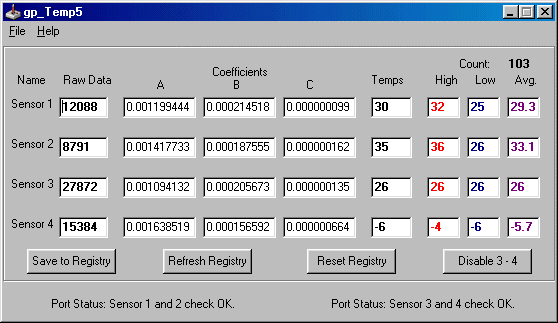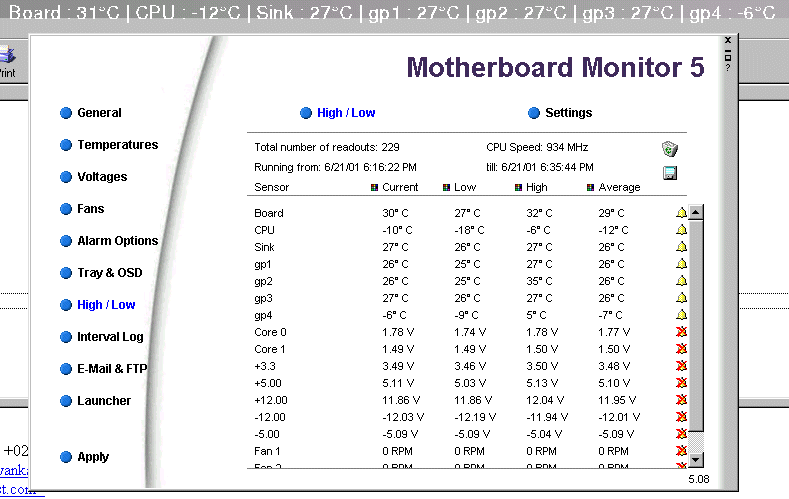
 |
 |
(Updated Jan.
23, 2003)
gp_Temp now works
with Motherboard Monitor 5.1.9.1 and later -- use the gp_Temp5.04 file
from the downloads page.
On the off-chance you are running Motherboard
Monitor 5.09, use gp_Temp5.03.
Download
gp_Temp5
Download
steinhart.zip
Thanks to those of you who suggested it, I have rewritten gp_Temp to work with the shared memory of Motherboard Monitor 5. While I am giving out thanks, thanks to those of you who have helped with the testing and - of course - special thanks to Alex van Kaam for the MBM software that has made playing with heat sinks so much more fun.
gp_Temp5 will read the temperature values of four 10k through 200k Ohm thermistors through the game port of your computer or sound card on Windows 95, 98, NT, Millennium, Windows 2000, and Windows XP systems. The temperatures may be read directly from gp_Temp5, but the program was mainly written so that the temps may be read from MBM5. Much nicer to have all of your temperatures displayed in one program.
gp_Temp5.04 is now works with all versions
of Motherboard Monitor from version 5.1.9.1 to present.
If, on the off chance you are running MBM 5.09, please use
gp_Temp5.03, otherwise, use
gp_Temp5.04
I have received a few comments that the 10k thermistors give less than optimal results at room temperature and above. Yes, this is true. For best results when measuring temperatures 25°C (77°F) and above, use 50k or 100k ohm thermistors. I realize that 10k thermistors are easier to find (hello Radio Shack), but the accuracy will suffer. 25°C is at the top of the range for a 10k thermistor when read through the game port. 10k thermistors also seem to make it harder to get proper coefficients. Some people have reported that they end up with negative numbers. Negative coefficients may not work well in gp_Temp5. If you receive negative coefficients, please read through the gp_Temp instructions starting here for a more in-depth explanation of how gp_Temp works and how to calibrate the program. If you continue to get negative coefficients, go ahead and try them - though the program seems to be more accurate when all of the coefficients are in the plus range.
If you are looking for a source for thermistors online, try Newark Electronics site.
50k ohm ntc thermistor from Thermometrics
- Thermometrics part number - DC95G503W -- Newark Electronics part
number 52F3334
100k ohm ntc thermistor from Thermometrics
- Thermometrics part number - DC95G104W -- Newark Electronics part
number 52F3329
While they are a little more pricey than the Radio Shack 10k thermistors at (US)$3.83 each as opposed to $2. at the shack, they are also a bit smaller in size. This is nice when you're trying to get them into small spaces.
If you're looking for a cheaper source for thermistors
(I am too), you'll benefit from the knowledge that most thermistors are
numbered similarly. In the part number DC95G503W, the
503 corresponds to 50 with 3 trailing zeros or 50,000 ohms. DC95G104W would
work out to 10 with 4 trailing zeros or 100,000 ohms. 103 in the part number would be 10 + 000 or 10k ohms.
Got it? You better have, 'cause there's going to be a test!
Screenshots
gp_Temp5 for Motherboard Monitor 5
 |
 |
I have found that displaying all seven temperatures (3 from the motherboard and another 4 from gp_Temp5) in the system tray makes things a bit crowded. However, with the use of the On Screen Display (OSD) of MBM, you can display the temps across the top of the screen. Since the OSD is "always on top," it can be seen in all programs. A neat feature. I use the following script:
<Temp 1 Name> : <Temp 1 Value> | <Temp 2 Name> : <Temp 2 Value> | <Temp 3 Name> : <Temp 3 Value> | <Temp 4 Name> : <Temp 4 Value> | <Temp 5 Name> : <Temp 5 Value> | <Temp 6 Name> : <Temp 6 Value> | <Temp 7 Name> : <Temp 7 Value>
This will keep all 7 temps on one line. If I position the OSD at about 30 on the horizontal plane, the temps don't interfere with the program names in each program's header.
As I have documented the process of assembling the thermistors and setting up the program in both gp_Temp and gp_Temp4, I'll won't be going through it again, but page 2 has the ReadMe from gp_Temp5 and page 3 contains the source code for the shared memory interface between gp_Temp5 and MBM5.
Well, that's about it. I hope the
program is useful. If you should encounter any bugs, please drop
me an e-mail E-mail Jim.
The setup information can be found by clicking on the link to the right or choosing gp_Temp5 page 2 at the bottom.
|
page 1 |
page 2 |
page 3 |
page 1 |
page 1 |
page 2 |
page 3 |